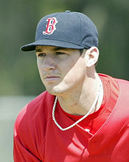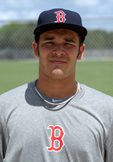February 29, 2012 at 8:19 AM
2012 Prospect Previews: Jose Vinicio and Christian Vazquez
 Jose Vinicio
Jose VinicioPosition: Shortstop
2011 Team: Gulf Coast Red Sox
2012 Projected Team: Lowell Spinners
Opening Day Age: 18
Strengths: Vincio demonstrates outstanding defensive instincts and has the tools to develop into an above-average defender with maturation. His quick first step, footspeed, and anticipation give him plus range, allowing him to cover exceptional ground to both his left or right. Athletic and agile, he is very light on his feet and balanced when making plays in the field. Vinicio shows the type of soft hands that fluidly adjust to the path of the ball, getting his glove in the proper position to eat up grounders hit in his direction. His defensive game is rounded out by a solid-average arm that has the potential to get stronger as he ages. Vinicio’s agility allows him to make off-balanced throws and ones on the run with control. Offensively, the switch hitter shows a fluid, compact stroke from the left- side of the plate. He generates plus batspeed as a lefty and is capable of getting around well on higher velocity fastballs. Despite being behind the curve in terms of physical development, Vincio squares offerings up well hitting left-handed and produces excellent backspin when getting the head of the bat out in front of pitches. The ball comes off his bat well. He has the hit tool to become a solid-average hitter for batting average, with the ability to maintain high contact rates and drive offerings into the gap on a line. Vinicio has the ceiling of a major league regular at the shortstop position.
Development Needs: Vinicio is extremely lean. He does not have the frame to evolve into a player whose power is a big part of his game, but needs to focus on adding strength to enhance both his offensive and defensive tools. Vinicio’s right-handed swing suffers due to his lack of strength. Longer than his swing as a lefty, he has trouble getting the head of the bat around on offerings and it drags through the hitting zone. He is behind more pitches, typically carving or slicing the ball against left-handed pitching. Physical development will aid Vinicio as a righty, but he also needs to work on using his hands more to hit inside the baseball and produce line drives rather than trying to air it out. With a power ceiling in the single digits for home run production, maintaining high rates of solid contact is going to carrying his offensive game. Vinicio is presently very aggressive with his pitch selection and does not use the opposite field with frequency. Becoming a more patient hitter is going to be key for his hit tool to develop even with physical development over the course of the next three to four seasons. Vinicio is also over-aggressive in the field, needlessly rushing plays or being too zealous when making throws. This leads to a lot of unforced errors. Slowing the game down is necessary for him to become a more sure-handed fielder, but should come with maturation.
2012 Outlook: Vinicio has spent the last two seasons in the Gulf Coast League. He has been on the young side and has also not been ready for more advanced competition due to his lack of physical development. Vinicio will more than likely stay back in extended spring training again this year, but should receive a placement with the Lowell Spinners to push his skills. He looked much more settled offensively during his time in the Fall Instructional League this past year, handling the advanced competition well. Vinicio will be playing against pitchers three or four years older than him during the season with Lowell. Expect some growing pains, but he has the developing skills to show flashes of line drive hitting potential. I see the more advanced secondary offerings he is going to face giving him trouble initially, but this will be a good challenge for him to adjust and push his selectiveness at the plate. Vinicio is very young, with a lot of development in front of him. The amount he physically matures is going to be a strong driver of his overall progression as a player. He has the type of tools that can translate quickly into in-game production when he begins to catch up physically. 2012 is another season to keep working to polish off his rough edges and build more of a professional approach at the plate.
 Christian Vazquez
Christian VazquezPosition: Catcher
2011 Team: Greenville Drive
2011 Projected Team: Salem Red Sox
Opening Day Age: 21
Strengths: Vazquez’s defensive game made strong strides last season. Possessing a sturdy and strong frame, he shows fluid movement from side-to-side when blocking pitches. Vazquez quickly reacts to balls bounced in the dirt, firing his feet to smother the pitch or getting big with his body to keep it in front of him. His footwork has improved from early in his career when his feet would become tangled and he struggled to control pitches in the dirt. Vazquez also is quick with his glove when going after off-line offerings and gives a very firm target when receiving pitches. He minimizes the amount of drift after the pitch hits his mitt. With continued progress learning the finer points of catching as he gets into the upper levels of the minors, he projects as a solid-average-to-better defender at the major league level. Vazquez’s glove can carry him up the ranks of the organization. With a well-filled out body, he has strong forearms and solid lower body strength. Vazquez shows solid-average raw power in batting practice sessions. He’s made improvements quickening up his swing load, with his batspeed grading as a slightly better than average. This has helped Vazquez get around better against fastballs middle-to-in and create more solid contact in the process. With more cleanup work to his swing load, he can project as about an average hitter for batting average.
Development Needs: Vazquez has a plus arm, but is still working on improving how he pops out of the crouch. He tends to be a bit slow with his release, which neutralizes his arm strength. His feet can also get tangled because he rushes and his accuracy suffers as a result. Vazquez has the ability to control the run game, but has to find a technique that fits to be more fluid when throwing. As he progresses into the upper minors he will also need to become more comfortable with being vocal out on the field and taking charge. At times, he can sit back a bit too much. Without great batspeed, Vazquez’s continued improvement quickening up his swing load will be vital to progress against the advancing level of competition. Fastballs above the belt can give him trouble. If he has to starts cheating by opening his lower body early to compensate, pitchers will take advantage of it with breaking balls. This will leave him more of a fringe-average hitter, with reduced zones for making solid contact. Incorporating his hands more into his swing will also aid with hitting inside of the baseball to take advantage of the whole field rather than relying on constantly pulling the ball to make hard contact. Vazquez may not tap fully into his power by adjusting, but maintaining adequate contact rates will give him a better shot at projecting as more than a backup at the major league level.
2012 Outlook: After more limited playing time prior to last season, Vazquez took advantage of his starting role with Greenville in 2011. He looks set to receive a placement in High A after the end of spring training. First and foremost, defense is a strong attribute for Vazquez. This season will serve as continued learning to assert himself during game action and more repetition with cleaning up his throwing mechanics. Improvement controlling the running game will continue to push him as a defender capable of handling the position at the major league level. His assignment with Salem also gives him further experience handling a pitching staff in preparation for entering the upper levels of the organization. The Carolina League can be a difficult offensive environment. The opposing pitchers show a lot more polish than the relatively inexperienced ones in the South Atlantic League. This will be a good challenge for Vazquez to adjust and continue working to quicken up his swing load. With less mistakes made, he will have to hit more at this level. There will most likely be a drop in power output, but maintaining similar contact rates to last season would be a good sign he is making progress adjusting. 2012 is a year to follow up his development strides and show he is pushing towards being ready for Double-A in 2013.
Chris Mellen is Director of Scouting for SoxProspects.com. Follow him on Twitter @ChrisMellen




















